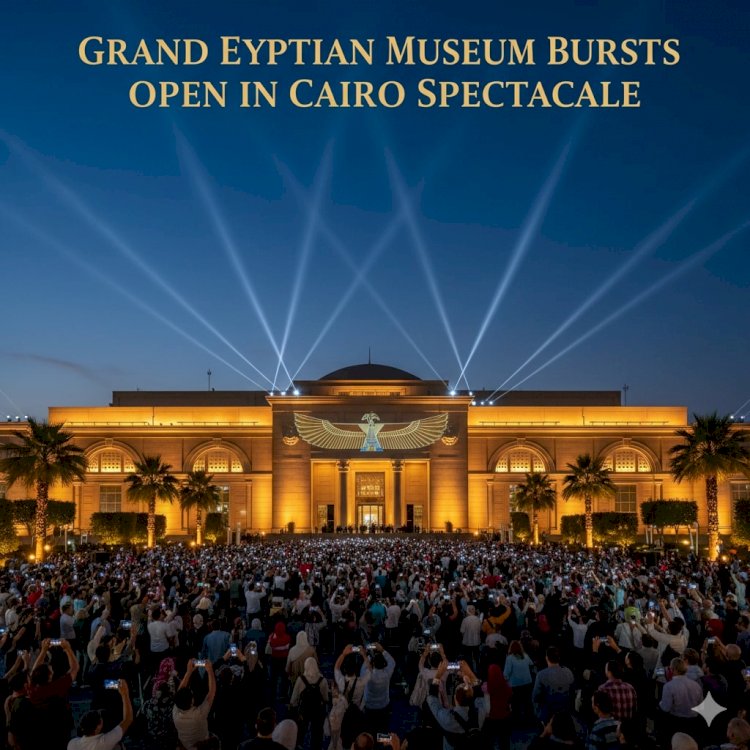Pharaohs Unearthed: Grand Egyptian Museum Bursts Open in Cairo Spectacle

Cairo, Egypt – November 2, 2025
In a moment that has tantalized history buffs and adventure seekers alike for over two decades, the Grand Egyptian Museum flung its colossal doors wide yesterday, unleashing a treasure trove of ancient wonders upon the world. Nestled on the sun-baked outskirts of Cairo, mere whispers from the eternal gaze of the Pyramids of Giza, this $1 billion behemoth promises to rewrite how we connect with the cradle of civilization.
The ribbon-cutting ceremony on November 1, 2025, unfolded like a scene from an Indiana Jones epic—minus the boulders and booby traps. Egyptian President Abdel Fattah el-Sisi, flanked by international dignitaries and a phalanx of archaeologists in crisp linen suits, declared the museum "a bridge from eternity to tomorrow." Crowds erupted in cheers as the first visitors streamed in, their gasps echoing off walls etched with hieroglyphs that whisper secrets of gods and kings.
From Desert Dream to Reality: A 33-Year Odyssey
What began as a bold vision in 1992 has finally crystallized into marble and myth. Construction kicked off in 2005, navigating funding hurdles, political upheavals, and the relentless march of time. Early soft launches in 2024 teased the public with glimpses of glory, but yesterday's full unveiling marked the true dawn. Spanning 1 million square meters—roughly the size of 200 soccer fields—the museum isn't just a repository; it's a resurrection of Egypt's golden age.
Imagine: 100,000 artifacts, many never before displayed, arranged in a narrative arc from prehistoric Nile dwellers to the Ptolemaic twilight. The star of the show? Tutankhamun's entire tomb collection, reassembled for the first time since Howard Carter cracked open that fateful sarcophagus in 1922. No more scattered shards in dusty Cairo basements—the boy king's golden mask now reigns supreme in a hall designed to mimic the Valley of the Kings.
Treasures That Time Forgot: Highlights Stealing the Spotlight
Step inside, and the air hums with antiquity. The museum's atrium, crowned by a massive falcon statue symbolizing Horus, serves as a gateway to themed galleries that pulse with life.
- The Pharaohs' Private Chambers: Here, Ramses II's colossal quartzite statue—taller than a giraffe—looms eternally youthful, his gaze challenging modern mortals. Nearby, Cleopatra's purported pearl earring dangles in a climate-controlled case, a nod to her legendary allure (and perhaps a wink to Hollywood's endless fascination).
- Mysteries of the Nile Underworld: Dive into the realm of the afterlife with papyrus scrolls unrolled like forbidden spells. One exhibit recreates a mummification ritual using holographic projections, turning visitors into wide-eyed apprentices amid the scent of simulated myrrh.
- Lost Wonders Reborn: For the tech-savvy explorer, augmented reality overlays breathe motion into static relics. Scan Nefertiti's bust, and watch her "speak" in reconstructed ancient Egyptian—her voice a silky timbre decoded from linguistic algorithms.
But it's not all solemn reverence. Interactive zones let families "build" their own pyramids with virtual blocks, while a Nile-side café brews coffee amid replicas of reed boats. "This isn't a museum; it's a portal," gushed one awestruck visitor, a schoolteacher from Alexandria. "My students will never see history as 'dead' again."
Echoes Across the Sands: Global Ripples and Local Pride
The opening isn't just Egyptian fireworks—it's a seismic shift for global tourism and cultural diplomacy. Already, bookings for guided tours have surged 300%, with airlines adding flights faster than scarab beetles multiply. UNESCO hailed it as "the most significant archaeological unveiling since the Rosetta Stone," positioning Cairo as the undisputed epicenter of ancient allure.
Locally, the museum injects life into Giza's economy, employing thousands in roles from curators to camel-tour guides. Youth programs tie ancient engineering to modern STEM, inspiring a new generation to safeguard their heritage. As the sun sets over the pyramids, casting golden hues on the museum's facade, one thing is clear: Egypt's past has never felt more alive.
Beyond the Sands: What Visitors Can Expect Next
Future expansions tease even grander spectacles—a virtual reality Nile cruise, seasonal exhibits from loaned global collections, and night tours under starlit skies mimicking ancient observances. With sustainability at its core, solar panels and recycled water systems ensure this wonder endures for millennia.
In a world racing toward the future, the Grand Egyptian Museum stands as a timeless anchor, reminding us that some stories are etched in stone—and they're just beginning to be told anew.

 content-team
content-team 
















